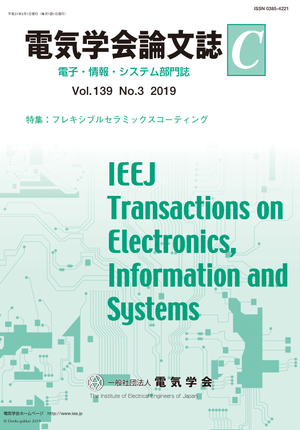Feature Extraction and Resident Number Prediction Method using Power Consumption Data
Feature Extraction and Resident Number Prediction Method using Power Consumption Data
カテゴリ: 論文誌(論文単位)
グループ名: 【C】電子・情報・システム部門
発行日: 2019/03/01
タイトル(英語): Feature Extraction and Resident Number Prediction Method using Power Consumption Data
著者名: Masahiro Yoshida (Hiroaki Nishi Laboratory, Graduate School of Science for Opens and Environmental Systems, Keio University), Tomoya Imanishi (Hiroaki Nishi Laboratory, Graduate School of Science for Opens and Environmental Systems, Keio University), Hiro
著者名(英語): Masahiro Yoshida (Hiroaki Nishi Laboratory, Graduate School of Science for Opens and Environmental Systems, Keio University), Tomoya Imanishi (Hiroaki Nishi Laboratory, Graduate School of Science for Opens and Environmental Systems, Keio University), Hiroaki Nishi (Department of System Design Engineering, Faculty of Science and Technology, Keio University)
キーワード: smart electric meter,feature extraction,feature selection,analysis of variance (ANOVA),ARMA model,machine learning
要約(英語): A large amount of power consumption information generated from private houses is being aggregated nowadays, particularly by the spread of smart electric meters. Applications that utilize these data are widely studied, and several services have been proposed. In order to utilize the power demand information effectively, an appropriate feature extraction and selection method is necessary. In this paper, a feature extraction method for power consumption information is proposed. Extracted features are used to predict the “number of household members (number of residents)” using typical machine learning algorithms, namely, Support Vector Machine (SVM), k-Nearest Neighborhood (k-NN), and Random Forest (RF). The number of residents represents significant information for the marketing departments of several industries such as real estate and construction industries. The proposed feature extraction method consists of two steps: feature variable generation and feature variable selection. In the feature variable generation step, we have used both fundamental statics and an ARMA model to generate 33 feature variables. In the feature variable selection step, the extracted feature variables are first ranked by applying Analysis of Variance (ANOVA). An appropriate feature variable set is selected by assessing several combinations of the 33 features, based on proposed extended algorithm of Recursive Feature Elimination (RFE). Our overall feature extraction method is evaluated based on the prediction accuracy using extracted feature variables. Compared with the accuracy using feature variables extracted by conventional methods, the accuracy is improved by 6.78%, 4.98%, and 8.11% for k-NN, SVM, and RF, respectively, and we have successfully proven validity of our proposition.
本誌: 電気学会論文誌C(電子・情報・システム部門誌) Vol.139 No.3 (2019) 特集:フレキシブルセラミックスコーティング
本誌掲載ページ: 227-236 p
原稿種別: 論文/英語
電子版へのリンク: https://www.jstage.jst.go.jp/article/ieejeiss/139/3/139_227/_article/-char/ja/
受取状況を読み込めませんでした


